
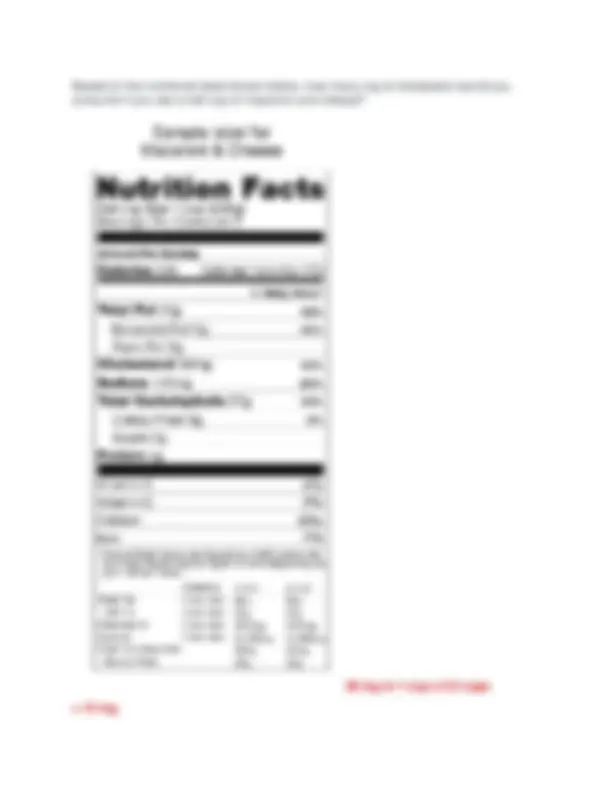
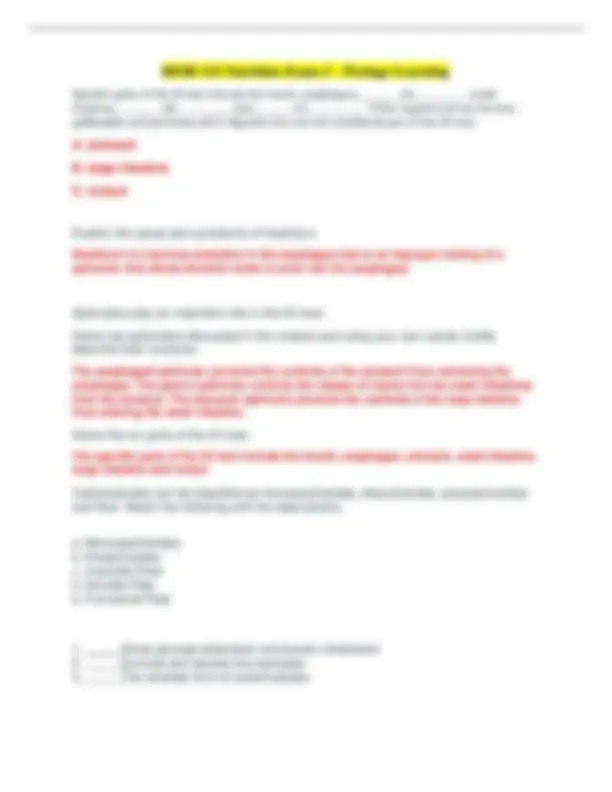
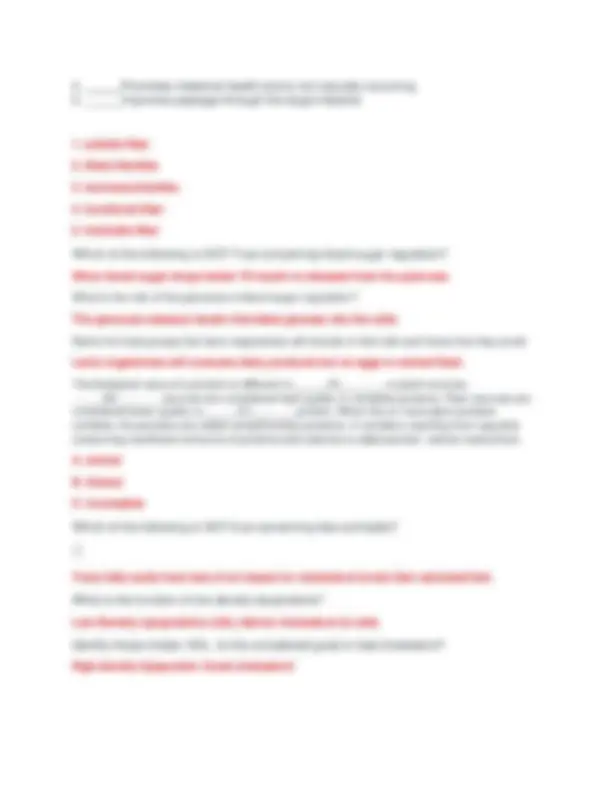
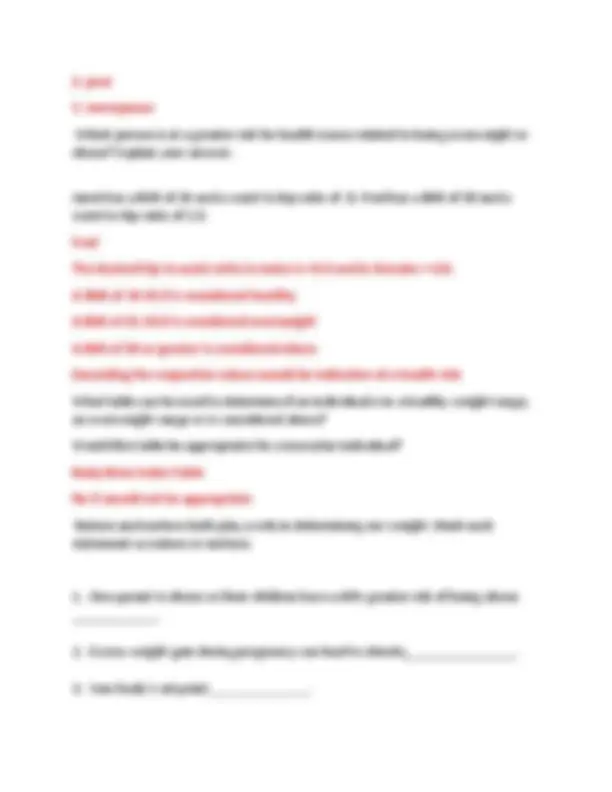
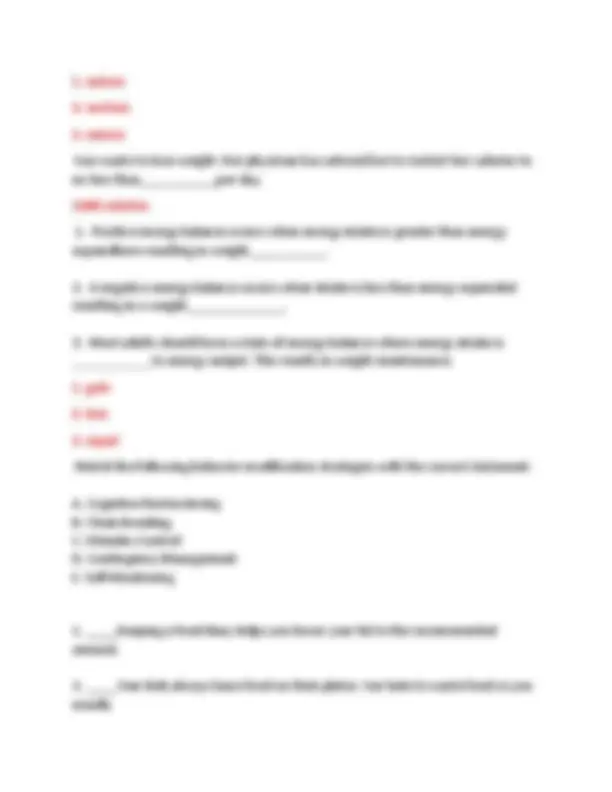
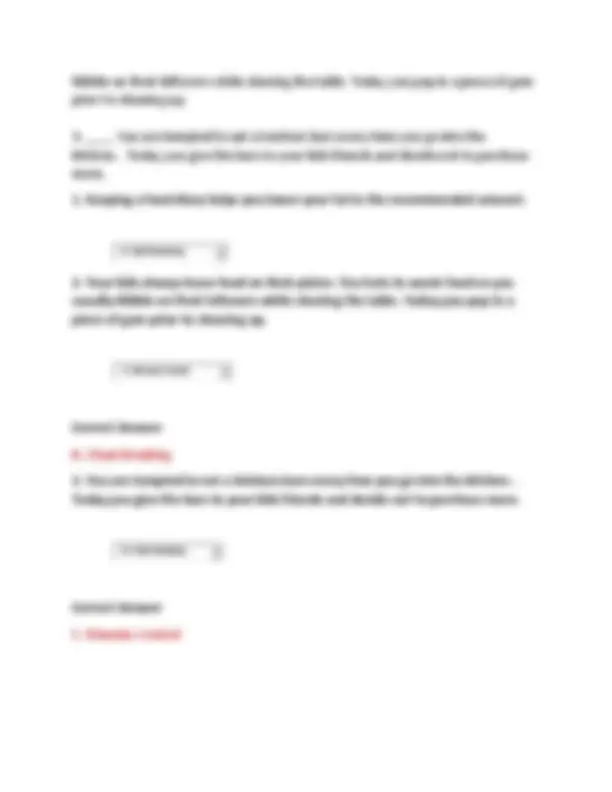
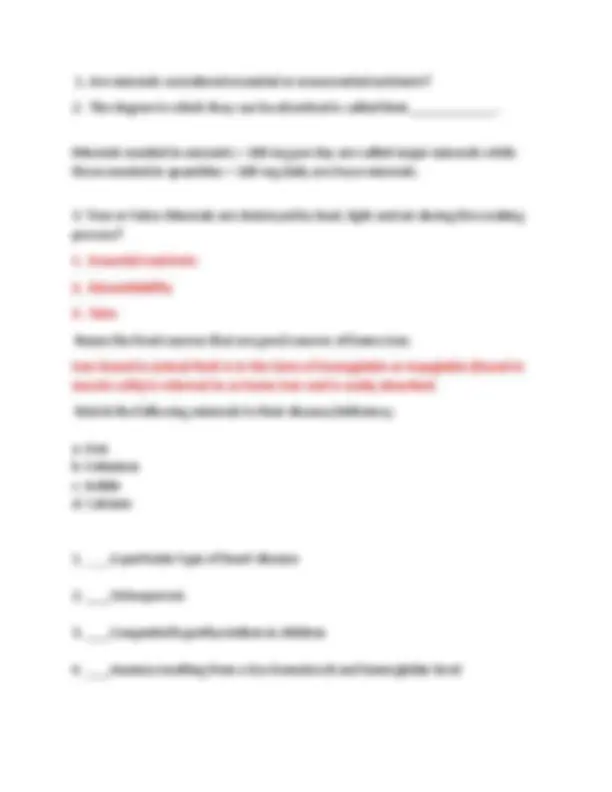

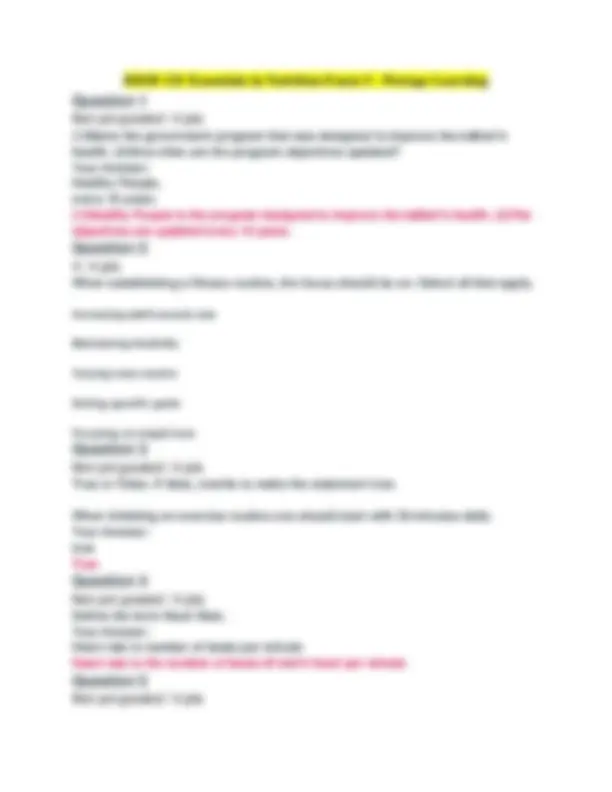
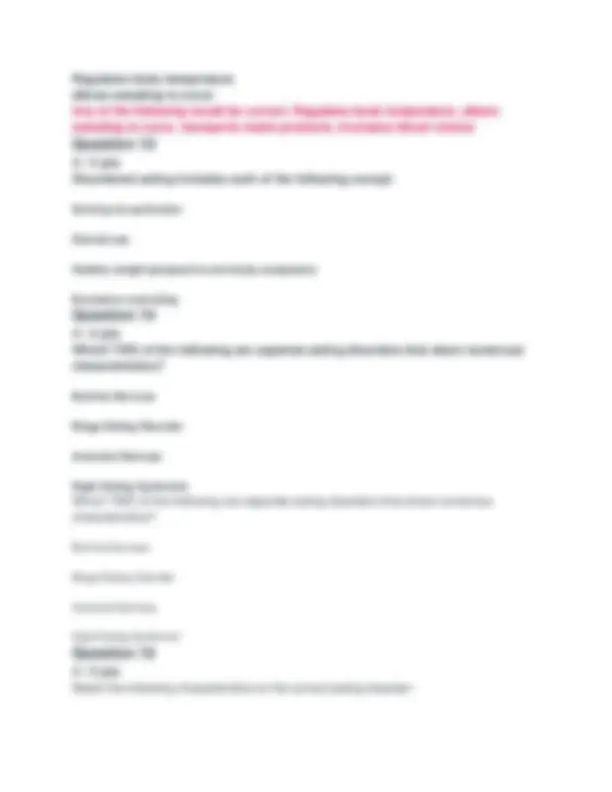
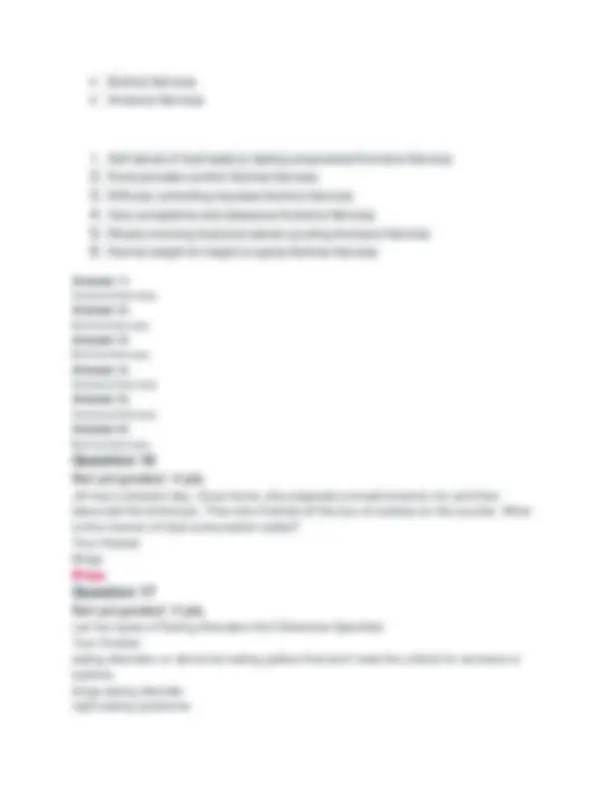
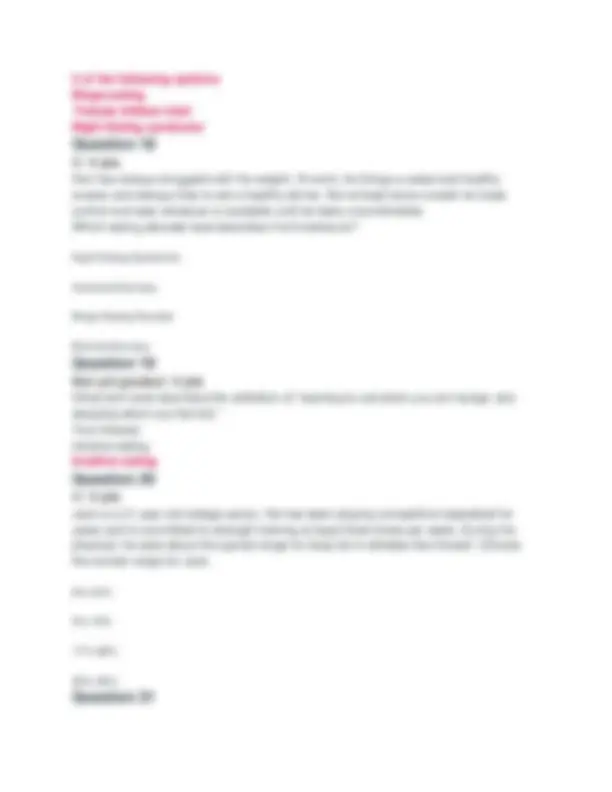
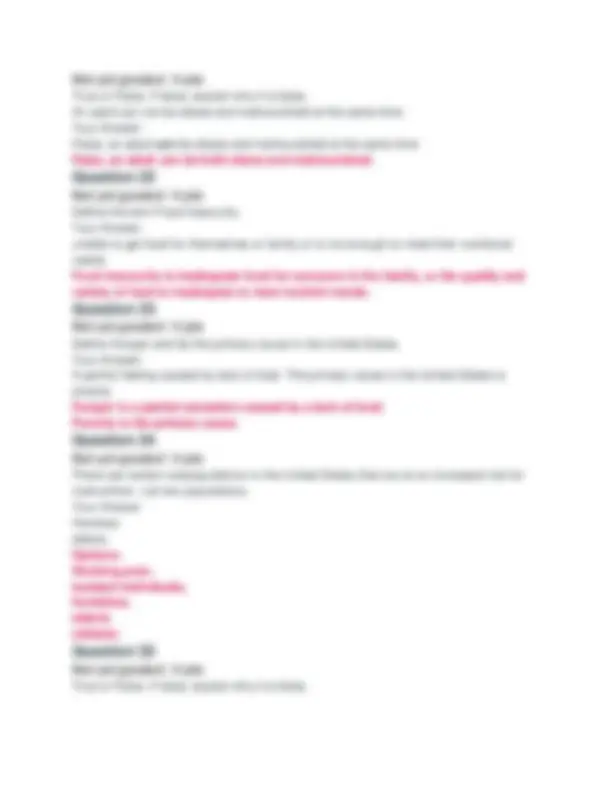

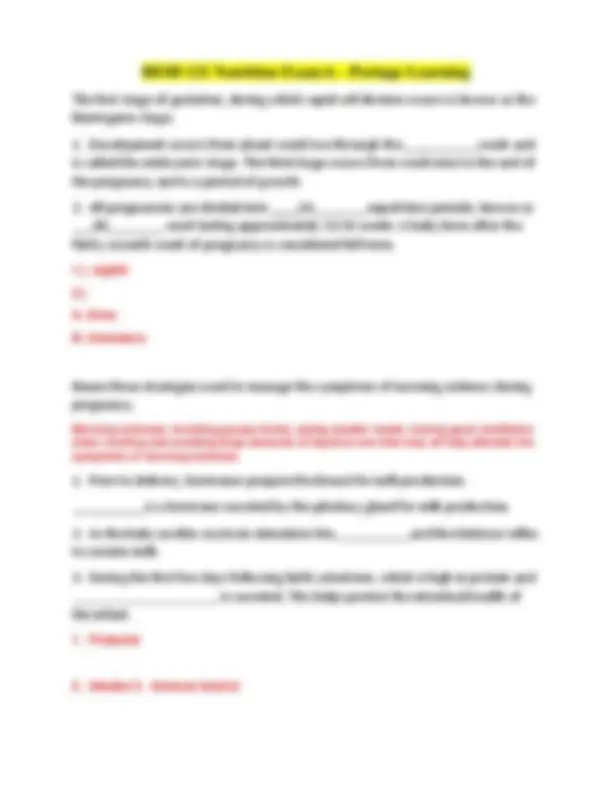
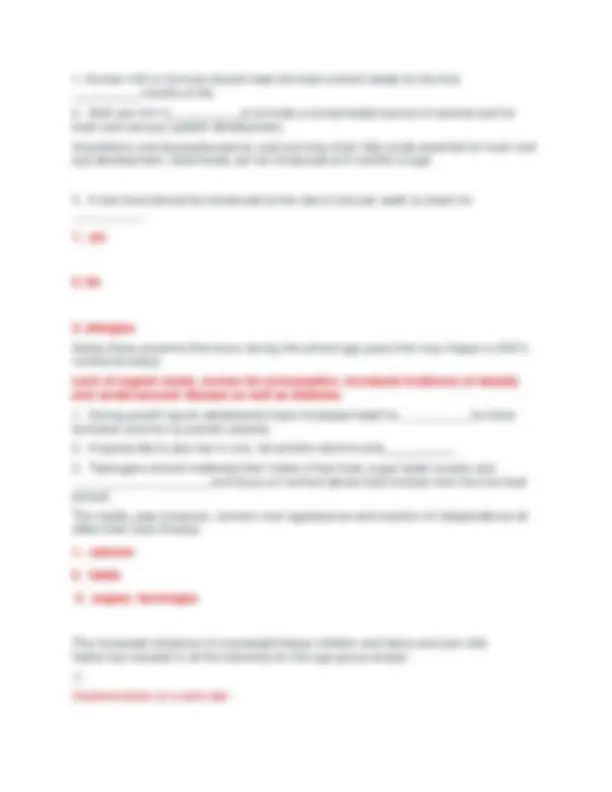
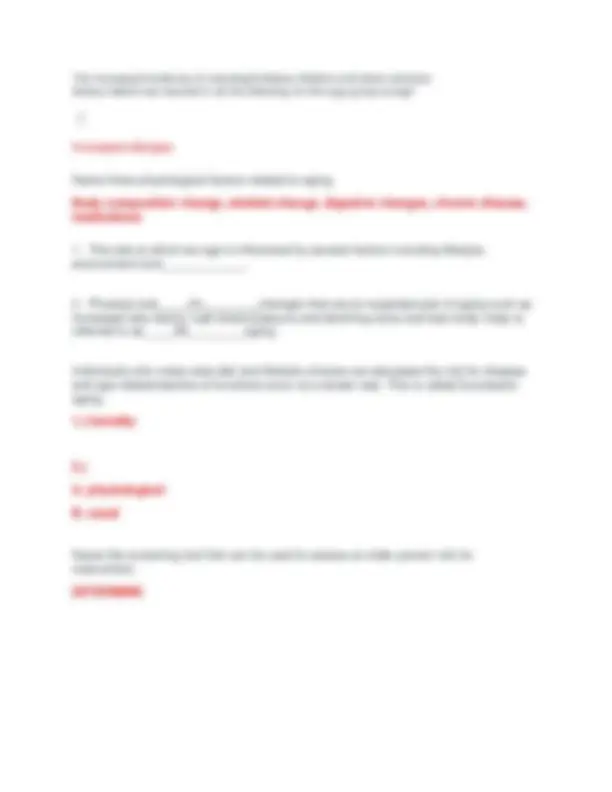



Study with the several resources on Docsity

Earn points by helping other students or get them with a premium plan


Prepare for your exams
Study with the several resources on Docsity

Earn points to download
Earn points by helping other students or get them with a premium plan
Community
Ask the community for help and clear up your study doubts
Discover the best universities in your country according to Docsity users
Free resources
Download our free guides on studying techniques, anxiety management strategies, and thesis advice from Docsity tutors
A comprehensive set of questions and answers covering key concepts in nutrition, ideal for students preparing for exams. topics include macronutrients, micronutrients, hunger and appetite regulation, dietary assessment, the gastrointestinal tract, blood sugar regulation, and weight management. the questions test understanding of various nutritional principles and their applications.
Typology: Exams
1 / 26

This page cannot be seen from the preview
Don't miss anything!



















List the two key hormones that are responsible for increasing and decreasing hunger and explain the role of each. Gherlin – hormone produced in the stomach that increases hunger. Leptin – hormone produced by fat cells that decrease hunger. List two examples of Environmental external forces that can influence eating habits and comment on your personal experience with each of them. Economics, Lifestyle, Cultural/Religious Beliefs, Local Environment
If a fudge brownie has 15 grams of carbohydrates, 2 grams of protein and 13 grams of fat. How many calories are in the brownie? 15 x 4 =60 2 x 4 = 8 13 x 9 = 117 60 +8 + 117= 185 calories The current recommendation to maintain your body weight is 2000 calories daily. You should not consume any more than 55 % of your calories from carbohydrates. How many grams of carbohydrates should you eat in a day? 275 grams (2000 x.55 =1100calories 1100calories/ 4 = 275 grams of carbs) There are three states of nutritional health. Name the three states overnutrition, undernutrition and desirable An individual’s health can be assessed using the ABCDEs of nutritional assessment. Give a brief description of what D stands for. Dietary- review of dietary intake and assessment MyPlate illustrates 3 concepts. Name the concepts: Variety, moderation, and balance.
BIOD 121 Nutrition Exam 2 – Portage Learning Specific parts of the GI tract include the mouth, esophagus, (A) , small intestine, (B) and (C). Other organs such as the liver, gallbladder and pancreas aid in digestion but are not considered part of the GI tract. A. stomach B. large intestine C. rectum Explain the cause and symptoms of heartburn. Heartburn is a burning sensation in the esophagus due to an improper closing of a sphincter that allows stomach acids to enter into the esophagus. Sphincters play an important role in the GI tract. Name two sphincters discussed in the module and using your own words, briefly describe their functions. The esophageal sphincter prevents the contents of the stomach from reentering the esophagus. The pyloric sphincter controls the release of chyme into the small intestines from the stomach. The ileocecal sphincter prevents the contents of the large intestine from entering the small intestine. Name the six parts of the GI tract. The specific parts of the GI tract include the mouth, esophagus, stomach, small intestine, large intestine and rectum Carbohydrates can be classified as monosaccharides, disaccharides, polysaccharides and fiber. Match the following with the descriptions. a. Monosaccharides b. Disaccharides c. Insoluble Fiber d. Soluble Fiber e. Functional Fiber
Males: EER = 662 - (9.53 x AGE) + PA x (15.91 x WT + 539.6 x HT) Females: EER = 354 - (6.91 x AGE) + PA x (9.36 x WT + 726 x HT) 1 kg = 2.2 pounds 1m = 39.37 inches Females: EER = 354 - (6.91 x AGE) + PA x (9.36 x WT + 726 x HT) where: AGE = 33 PA = 1.12 (from chart) WT = 130 lbs x 1 kg/2.2 lbs = 65.9 kg HT = 69 in x 1 m/ 39.37 in = 1.75 m Plug in the numbers for the variables: EER = 354 - (6.91 x 33) + 1.12 x (9.36 x 65.9 + 726 x 1.75) Multiply the numbers inside the parenthesis: EER = 354 - (228) + 1.12 x (616.8 + 1270.5) Add inside the parenthesis: EER = 354 – 228 + 1.12 x 1887. Multiply before adding: EER = 354 – 228 + 2113. Add and Subtract: EER = 2239.8 calories
**2. pear
Nibble on their leftovers while clearing the table. Today you pop in a piece of gum prior to cleaning up.
Fat soluble vitamins have all the following characteristics except : They are inorganic Fat soluble vitamins have all the following characteristics except : Correct! All are synthesized by the body
**1. A particular type of heart disease
Paul is a 50 year old male. Julie is a 30 year old female. Would his maximum heart rate be higher or lower than Julie’s maximum heart rate? Show your calculations. Your Answer: Max Heart Rate Paul: 220-50=170 beats per minute Julie: 220-30= 190 beats per minute Pauls heart rate would be lower Paul’s maximum heart rate 220 - 50 = 170 beats per minute Julie’s maximum heart rate 220 - 30 = 190 beats per minute Paul’s would be lower.
4 / 4 pts Order the following macronutrients from 1 to 4 according to the order that cells utilize them for energy requirements with 1 being the first resource to be used, and 4 being the last resource to be utilized. 1. Adenosine Triphosphate 2. Carbohydrates 3. Fats 4. Protein
Not yet graded / 4 pts Name the two tissues in the body where glycogen is stored. Your Answer: muscles and liver Liver and muscle
Not yet graded / 4 pts True or False. If false, explain why it is false. When strength training, protein is the most important nutrient for optimum performance. Your Answer:
False Carbohydrates are the most important nutrient for optimum performance during strength training False. When strength training, carbohydrates are the most important nutrient for optimum performance.
Not yet graded / 4 pts As an athlete, it is difficult to meet nutrient needs when the calorie intake is less than calories. Your Answer: 1,800 kcal Less than 1400 calories
4 / 4 pts Each of the following are true except: The average adult requires 8 cups of fluid per day The average adult requires 9 - 11 cups of fluid per day A water loss greater than 3% can affect an athletes performance Water regulates body temperature Urine should be clear or pale in color
4 / 4 pts Symptoms of Heatstroke include: select all that apply Nausea/vomiting An internal temperature of 104 degrees Dry, hot skin Muscle cramps
Not yet graded / 4 pts Paul is in high school and participates in several sports. He does not like the taste of water and prefers sports beverages. You want to encourage Paul to drink more water. State two functions of water that you would share with Paul. Your Answer:
Answer 1: Anorexia Nervosa Answer 2: Bulimia Nervosa Answer 3: Bulimia Nervosa Answer 4: Anorexia Nervosa Answer 5: Anorexia Nervosa Answer 6: Bulimia Nervosa
Not yet graded / 4 pts Jill had a stressful day. Once home, she prepared a boxed brownie mix and then devoured the entire pan. Then she finished off the box of cookies on the counter. What is this manner of food consumption called? Your Answer: Binge Binge
Not yet graded / 4 pts List two types of Eating Disorders Not Otherwise Specified. Your Answer: eating disorders or abnormal eating patters that dont meet the criteria for anorexia or bullimia binge eating disorder night eating syndrome
2 of the following options: Binge-eating Female Athlete triad Night Eating syndrome
4 / 4 pts Ken has always struggled with his weight. At work, he brings a salad and healthy snacks and always tries to eat a healthy dinner. But at least twice a week he loses control and eats whatever is available until he feels uncomfortable. Which eating disorder best describes Ken’s behavior? Night Eating Syndrome Anorexia Nervosa Binge Eating Disorder Bulimia Nervosa
Not yet graded / 4 pts What term best describes the definition of “learning to eat when you are hungry and stopping when you feel full.” Your Answer: intuitive eating Intuitive eating
4 / 4 pts Jack is a 21 year old college senior. He has been playing competitive basketball for years and is committed to strength training at least three times per week. During his physical, he asks about the typical range for body fat in athletes like himself. Choose the correct range for Jack. 8%-24% 5%-18% 17%-28% 20%-35%